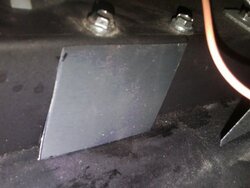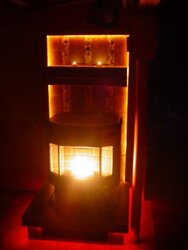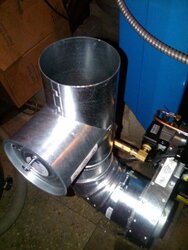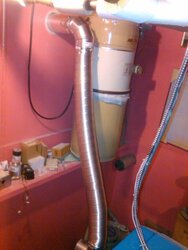HI, I was cleaning my stove (Astoria) and took a few minutes to take off the back panel and noticed that the OAK pipe ran to the stove where just inside the grate the air intake line had a rectangle piece missing. Meaning when the air intake sucked air it would get it from the easier of the outside or my house. Is this correct? Seems like the outside air kit intake line should not have a hole in it. I can take a picture put I was hoping someone could confirm that I should cover that hole or leave it open. I can't imagine why it would be open with the OAK installed though.
avalon astoria OAK question
- Thread starter quickrch
- Start date
-
Active since 1995, Hearth.com is THE place on the internet for free information and advice about wood stoves, pellet stoves and other energy saving equipment.
We strive to provide opinions, articles, discussions and history related to Hearth Products and in a more general sense, energy issues.
We promote the EFFICIENT, RESPONSIBLE, CLEAN and SAFE use of all fuels, whether renewable or fossil.
You are using an out of date browser. It may not display this or other websites correctly.
You should upgrade or use an alternative browser.
You should upgrade or use an alternative browser.
- Status
- Not open for further replies.
I
imacman
Guest
This has been discussed before. I had an Astoria, and noticed the missing square in the OAK inlet tube, and called Travis Ind. They stated that the stove was designed that way, and I should leave it alone.
It still pulls air from outside, but mixes w/ interior air.
Don2222 has a thread here somewhere that has pics. He also tried covering the hole.
It still pulls air from outside, but mixes w/ interior air.
Don2222 has a thread here somewhere that has pics. He also tried covering the hole.
imacman said:This has been discussed before. I had an Astoria, and noticed the missing square in the OAK inlet tube, and called Travis Ind. They stated that the stove was designed that way, and I should leave it alone.
It still pulls air from outside, but mixes w/ interior air.
Don2222 has a thread here somewhere that has pics. He also tried covering the hole.
Thanks, I searched for it bt didn't see a specific post about it. Looks like it worked on high but not on others. I'll look again tomorrow.
gerald
New Member
Breckwell Pellet Stoves use the same idea, I think many other manufactures as well. Codes call for a source of outside air. Doesn't really specifies that it must use outside air. I am guessing, but probably a way to cut manufacturing cost. I have had customer fabricate an extension between the source and the stove. Not sure if this is a good idea as now the stove has been modified, but it worked.
Hello quickrch
Travis would not discuss why that square hole is in the outside air kit (OAK) inside the stove on the left side of the Intake Air Plenum. Therefore since I am an Engineer, I had to figured it out myself.
Imacman is correct, it mixes heated inside room air with the incoming OAK air to burn the wood pellets. The reason is to assure that the air for burning is warm and dry. On high heat settings it does not make much difference, but many stoves do not work on the lowest heat setting like the Astoria. On the low heat setting the heated air keeps the burn pot completely free of caked ash and the air holes are almost always clear and not clogged.
So I tried blocking the square hole with a piece of aluminum flashing I had from Home Depot. I the fall on the low heat setting I noticed alot of caked ash in the burn pot and the air holes became clogged after a day or so. I am currently running the stove with the hole blocked in the winter on heat setting 2 and it is working quite well but I have a 15 foot OAK that also warms the air slightly by the time it reaches the stove.
What I have found by blocking this square hole is that the house warms up much faster when I turn the stove on and I can keep the house warm on one lower heat setting than I normally did last winter. This saves FUEL which saves MONEY and makes the house less drafty and more comfortable.
So currently I am investigating ways to warm the Outside air without unblocking the square hole. So here are my ideas:
1. Use the SelKirk Direct Temp / Pellet Flue Venting that brings in fresh air over the exhaust air. This will warm the air without additional energy.
http://www.selkirkcorp.com/supervent/Product.aspx?id=7428
2. Using a metal trash can, connect a the OAK hose from the outside to the bottom side of the can and the stove to the top side of the can. The trash can will act like an indirect water tank on a boiler and warm the air.
Pic shows square hole blocked below:
Travis would not discuss why that square hole is in the outside air kit (OAK) inside the stove on the left side of the Intake Air Plenum. Therefore since I am an Engineer, I had to figured it out myself.
Imacman is correct, it mixes heated inside room air with the incoming OAK air to burn the wood pellets. The reason is to assure that the air for burning is warm and dry. On high heat settings it does not make much difference, but many stoves do not work on the lowest heat setting like the Astoria. On the low heat setting the heated air keeps the burn pot completely free of caked ash and the air holes are almost always clear and not clogged.
So I tried blocking the square hole with a piece of aluminum flashing I had from Home Depot. I the fall on the low heat setting I noticed alot of caked ash in the burn pot and the air holes became clogged after a day or so. I am currently running the stove with the hole blocked in the winter on heat setting 2 and it is working quite well but I have a 15 foot OAK that also warms the air slightly by the time it reaches the stove.
What I have found by blocking this square hole is that the house warms up much faster when I turn the stove on and I can keep the house warm on one lower heat setting than I normally did last winter. This saves FUEL which saves MONEY and makes the house less drafty and more comfortable.
So currently I am investigating ways to warm the Outside air without unblocking the square hole. So here are my ideas:
1. Use the SelKirk Direct Temp / Pellet Flue Venting that brings in fresh air over the exhaust air. This will warm the air without additional energy.
http://www.selkirkcorp.com/supervent/Product.aspx?id=7428
2. Using a metal trash can, connect a the OAK hose from the outside to the bottom side of the can and the stove to the top side of the can. The trash can will act like an indirect water tank on a boiler and warm the air.
Pic shows square hole blocked below:
Attachments
Don2222 thanks for that detailed explanation. I put a piece of aluminum tape (several pieces actually) over the hole now and will see how that goes in terms of burning. The intake line is too hot to touch when the stove is on high so I am sure the air is plenty hot. I didn't put this in the original post but the reason I check at all was because I could smell smoke in our house from a bonfire in the yard. That is very unusual and when I smelled it I wondered why the house was taking in air (the dryer was not running). I wondered if our installer had not done a good job but then found that the installer did what he was supposed to.
For my setup the thimble has the chimney and OAK hole in it and it is the horizontal setup and the OAK is probably less than 3 feet. I wonder if there is a way to poach some hot air from the chimney to heat the OAK. My setup has the stove near the wall but the OAK could easily be moved closer to that hot pipe. I don't know but I doubt I'll modify it any more. We run on high most of the time because of the large space being heated so I doubt that would be an issue. I'll see how cleaning the burn pot goes the next few days.
It seems like it wouldn't be too difficult to install a slider on the plenum and cut a 1/8" slot in the back of the stove and just slide it as needed. Better yet use a metal push rod through the holes alread in the back. Maybe use a thicker piece and cut a groove in it with a dremmel or other tool and install on the air intake line as a guide. Similarly you could seat the slider on a similarly constructed piece. Just a thought.
For my setup the thimble has the chimney and OAK hole in it and it is the horizontal setup and the OAK is probably less than 3 feet. I wonder if there is a way to poach some hot air from the chimney to heat the OAK. My setup has the stove near the wall but the OAK could easily be moved closer to that hot pipe. I don't know but I doubt I'll modify it any more. We run on high most of the time because of the large space being heated so I doubt that would be an issue. I'll see how cleaning the burn pot goes the next few days.
It seems like it wouldn't be too difficult to install a slider on the plenum and cut a 1/8" slot in the back of the stove and just slide it as needed. Better yet use a metal push rod through the holes alread in the back. Maybe use a thicker piece and cut a groove in it with a dremmel or other tool and install on the air intake line as a guide. Similarly you could seat the slider on a similarly constructed piece. Just a thought.
joey70
New Member
So Don would you need just the adapter that has the oak fitting on the vent or would you need the whole setup......would be a nice alternative before i go cutting a hole in my wall.....and how does that work it uses the air coming from the stove or air from out side..
kofkorn
Feeling the Heat
Don,
Your two methods are both valid, but your second method isn't really much better than taking the intake air from the room. If you are using the room air to warm the intake, then you are effectively cooling the room air.
I would look at the Selkirk or some other method. Maybe run your current double wall pipe inside a 4" or 5" pipe? The outside of the double wall pipe is certainly much warmer than your room air. You could use a couple of "T"'s. Slide one on each end of the 4" pipe and then put as much straight 4" pipe as you need to get the temperature you want. Then port one "T" to the outside and the other to your stove intake. Use some High temp silicone to close the gaps between the open ends of the "T"s and the double wall exhaust pipe.
Hope that makes sense
Your two methods are both valid, but your second method isn't really much better than taking the intake air from the room. If you are using the room air to warm the intake, then you are effectively cooling the room air.
I would look at the Selkirk or some other method. Maybe run your current double wall pipe inside a 4" or 5" pipe? The outside of the double wall pipe is certainly much warmer than your room air. You could use a couple of "T"'s. Slide one on each end of the 4" pipe and then put as much straight 4" pipe as you need to get the temperature you want. Then port one "T" to the outside and the other to your stove intake. Use some High temp silicone to close the gaps between the open ends of the "T"s and the double wall exhaust pipe.
Hope that makes sense

joey70 said:So Don would you need just the adapter that has the oak fitting on the vent or would you need the whole setup......would be a nice alternative before i go cutting a hole in my wall.....and how does that work it uses the air coming from the stove or air from out side..
You need all the venting from SelKirk because it is double walled. The inner wall expels the exhaust gases to the outside and the outer wall brings in the fresh air. The fresh air will be warmed by the inner hot wall of the flue gases.
kofkorn said:Don,
Your two methods are both valid, but your second method isn't really much better than taking the intake air from the room. If you are using the room air to warm the intake, then you are effectively cooling the room air.
I would look at the Selkirk or some other method. Maybe run your current double wall pipe inside a 4" or 5" pipe? The outside of the double wall pipe is certainly much warmer than your room air. You could use a couple of "T"'s. Slide one on each end of the 4" pipe and then put as much straight 4" pipe as you need to get the temperature you want. Then port one "T" to the outside and the other to your stove intake. Use some High temp silicone to close the gaps between the open ends of the "T"s and the double wall exhaust pipe.
Hope that makes sense
In the second method I am suggesting to run the flexible aluminum OAK line from the outside into the bottom of a sealed metal trash can. Then run another flexible aluminum pipe from the top or top side of the sealed metal trash can to the OAK intake on the stove. No inside air would be used!
quickrch said:Don2222 thanks for that detailed explanation. I put a piece of aluminum tape (several pieces actually) over the hole now and will see how that goes in terms of burning. The intake line is too hot to touch when the stove is on high so I am sure the air is plenty hot. I didn't put this in the original post but the reason I check at all was because I could smell smoke in our house from a bonfire in the yard. That is very unusual and when I smelled it I wondered why the house was taking in air (the dryer was not running). I wondered if our installer had not done a good job but then found that the installer did what he was supposed to.
For my setup the thimble has the chimney and OAK hole in it and it is the horizontal setup and the OAK is probably less than 3 feet. I wonder if there is a way to poach some hot air from the chimney to heat the OAK. My setup has the stove near the wall but the OAK could easily be moved closer to that hot pipe. I don't know but I doubt I'll modify it any more. We run on high most of the time because of the large space being heated so I doubt that would be an issue. I'll see how cleaning the burn pot goes the next few days.
It seems like it wouldn't be too difficult to install a slider on the plenum and cut a 1/8" slot in the back of the stove and just slide it as needed. Better yet use a metal push rod through the holes alread in the back. Maybe use a thicker piece and cut a groove in it with a dremmel or other tool and install on the air intake line as a guide. Similarly you could seat the slider on a similarly constructed piece. Just a thought.
Thanks I am glad the info was helpful, It took a while to figure it out!
Please let us know if blocking the hole stops the bonfire burning smell from coming in. If it does you should write to Sean Hanley the service tech at Travis. I did and suggested a sliding cover for that hole to be designed into the stove. Something to give a savy user like us room to adjust the stove for our needs.
Also would like to see some pics of your stove too.
Sean's email is:
"Sean Hanley" <[email protected]>
BTW, I had to put the stove on heat setting 4 early this morning to keep the 2,000 split entry warm. However if the hole was not blocked I would have had to increase the setting to 5 even 6. It was 3 degrees at 9 PM last night and only warmed up to 15 degrees this morning!
Attachments
kofkorn
Feeling the Heat
Hi Don,
I understood that. The best way I can describe it is that your trash can is a heat exchanger, taking the heat from the air inside your house and transferring it to the intake air inside the can. It's like running a radiator in reverse. You are warming your intake air at the expense of the room air. No inside air is being used, but you are still cooling the inside air.
Unless the trash can is outside, and then I don't understand at all.
I understood that. The best way I can describe it is that your trash can is a heat exchanger, taking the heat from the air inside your house and transferring it to the intake air inside the can. It's like running a radiator in reverse. You are warming your intake air at the expense of the room air. No inside air is being used, but you are still cooling the inside air.
Unless the trash can is outside, and then I don't understand at all.
kofkorn said:Hi Don,
I understood that. The best way I can describe it is that your trash can is a heat exchanger, taking the heat from the air inside your house and transferring it to the intake air inside the can. It's like running a radiator in reverse. You are warming your intake air at the expense of the room air. No inside air is being used, but you are still cooling the inside air.
Unless the trash can is outside, and then I don't understand at all.
Hi Kofkorn
Now I understand what you are saying here. Well the trash can still maybe better than the square hole in the air intake plenum that is taking room air and sending it up the chimney.
In my case the trash can would be located between my pellet stove and the oil boiler so there is a bit more excessive heat right there.
My boiler also has an OAK on it. The boiler analyst recommends at least a 10 foot OAK on the boiler so the air will be warmed. He has seen problems with -10 degree air outside going into the oil burner and causing some vibration.
So warming the air is a good thing to do, I am just trying to find the best way!!
See pic below of Carlin Burner Air Boot and Flex Aluminum pipe to the outside!
Attachments
- Status
- Not open for further replies.
Similar threads
- Replies
- 6
- Views
- 866
- Replies
- 2
- Views
- 481
- Replies
- 0
- Views
- 594
- Replies
- 6
- Views
- 786





